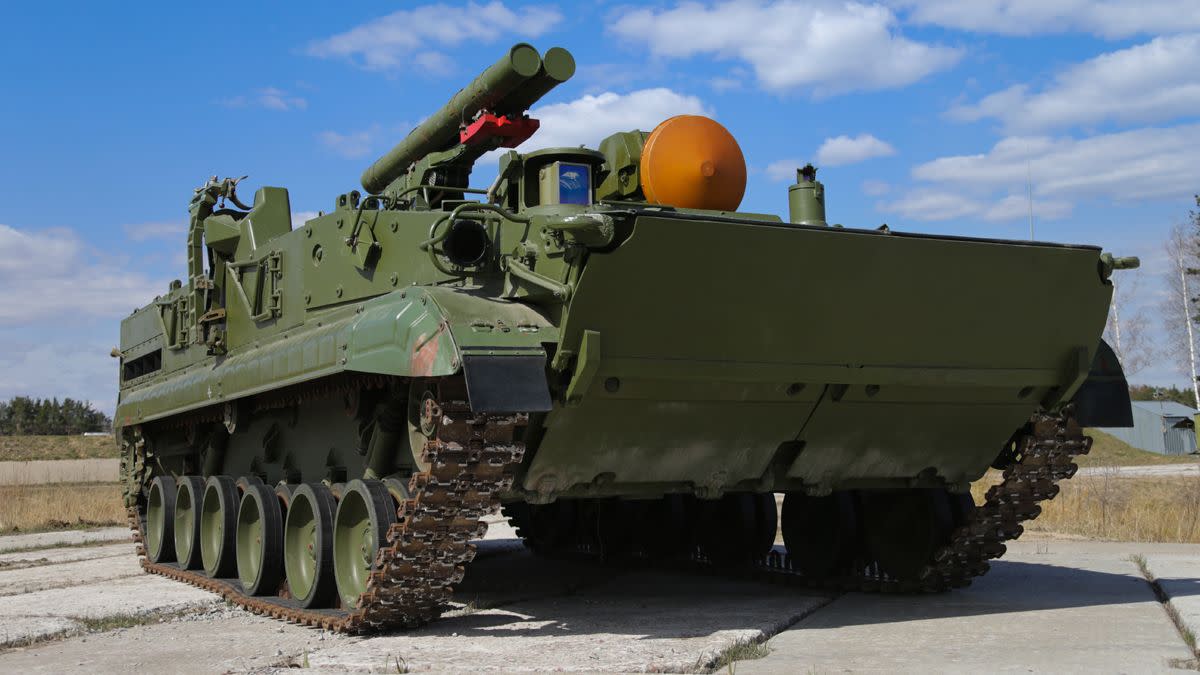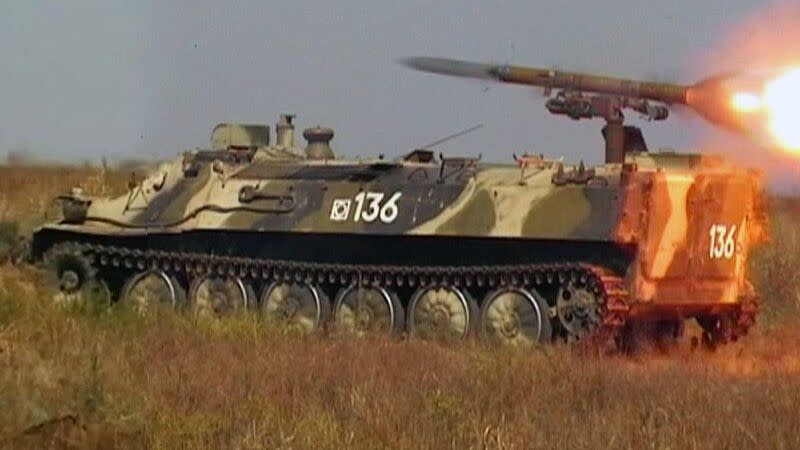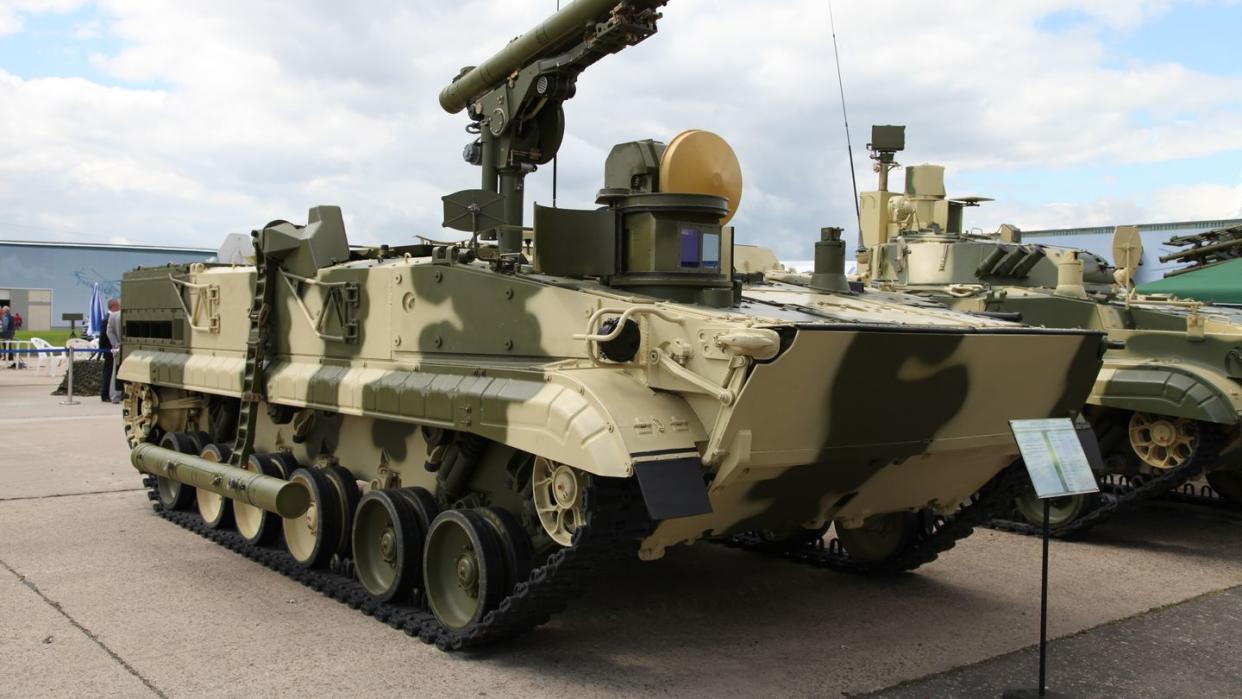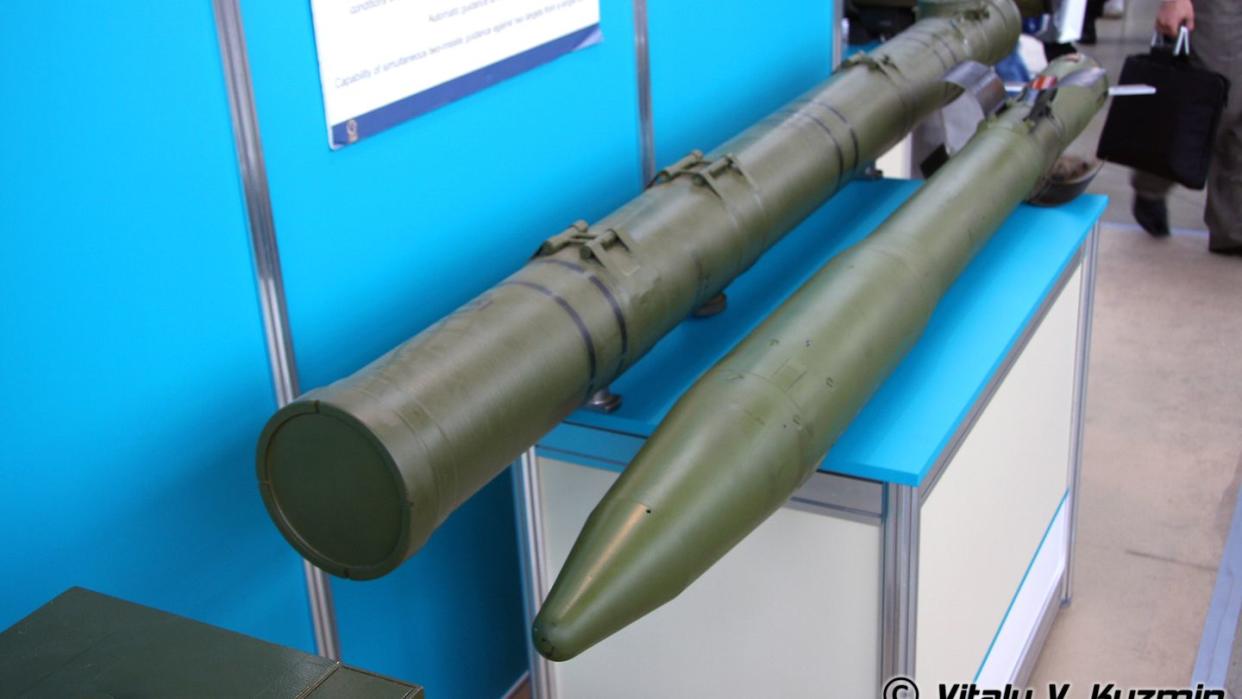Russia’s Supersonic 'Chrysanthemum' Missile May Finally Be Used on Tanks

An extended-range variant of Russia’s 9M123 Khrizantema (“Chrysanthemum”) supersonic anti-tank missile was unveiled mid-August at Russia’s Army-2023 arms expo. It’s intended to pose a long-distance threat to NATO’s heavy main battle tanks—if, that is, Russia ever procures it in more than boutique quantities.
Unlike most anti-tank guided missiles that usually come in forms for dismounted use, the 9M123 (codenamed AT-15 Springer by NATO) is uniquely fired from a two-shot pop-up launcher on a dedicated armored vehicle that’s based on the BMP-3 infantry fighting vehicle called the 9P157-2 Khrizantema-S.
At its peak Mach 1.3 velocity, a Khrizantema missile traverses a mile in just four seconds, closing with the target much faster than typical anti-tank guided missiles. (One Russian source differs, claiming that the maximum speed is closer to Mach 1.9)
Spitting out up to four missiles per minute using automatic loaders, manufacturer KBM claims that a platoon of three Khrizantema-Ss can disable a company of 14 tanks in two minutes, assuming an estimated 60% kill probability per shot. The 9M123 missile can also be used against low-flying helicopters, but can’t target vehicles closer than 400 meters away.
#Russia: Rostec presents 9M123M and 9M123MF "Khrizantema" guided anti-tank missile with a claimed penetration of 1.1m (1100mm). pic.twitter.com/Uprcbmn1iV
— Vigorous Falcon (@VigorousFalcon) August 15, 2023
The new, enlarged 9M123M missile displayed at Army 2023 not only boasts 68% extended range of 6.2 miles (up from 3.3-3.7 miles), but supports launch from Russia’s Mi-28NM ‘Havoc’ and Ka-52 attack helicopters. A display card implies the 152-millimeter diameter missile is longer (2.3 versus 2.06 meters) and weighs more in its launch tube (140.7 lbs up from 119 pounds) than the base model. In the past, builder KBM has claimed the improved missile would tweaked to improve odds of overcoming add-on cage (or ‘lattice’) armor.
Interestingly, the claimed 1,100-millimeters RHA equivalent armor penetration remain below previously circulated estimates of 1,200 to 1,250-millimeters for the base model. 1,100 RHA is less than the commonly estimated maximum chemical-energy protection on the front turret of modern Abrams or Leopard 2 tanks. That said, tanks don’t only get hit where their armor is thickest, so the missile remains a real threat.
Russian 9P157 Khrizantema-S ATGM carrier in action somewhere in the Kherson Oblast of Ukraine. pic.twitter.com/oADn2KP1CQ
— Status-6 (@Archer83Able) July 14, 2022
Only a few videos show Khrizantema’s use in combat, reflecting that only a few dozen systems were procured. And rather than blasting Leopard 2 main battle tanks charging towards Russian lines, two shows them plinking at surveillance cameras fixed to a distant building like a thief in a heist caper.
Chrysanthemum in war time!
Soldiers of the #Russian 110 bgde using the "Khrizantema" anti-tank missile system, hitting #Ukrainian OPs on high rise buildings in urban battles. pic.twitter.com/Kfhf4x0sQa— Sandeep Mukherjee (@Libertarian196) April 23, 2023
Video of a Russian Khrizantema-S ATGM carrier strike in the Mykolaiv direction. The source says that Ukraine is using cameras on tall buildings and towers, which was the target of this strike.https://t.co/QTazmr4EBT pic.twitter.com/BhmY1zbohx
— Rob Lee (@RALee85) August 10, 2022
Another Khrizantema strike is seen destroying an uncrewed anti-tank guided missile firing post, again on the roof of a building.
Russian Khrizantema missile destroys Ukrainian ATGM launcher on top of an apartment building. Near Krasnogorovka, #Donetsk region pic.twitter.com/xfUd6oHb5j
— Truth Seeker (@rishatjnu) May 20, 2023
Joking aside, these are valid targets that highlight the Chrysanthemum’s long range and accuracy, even if they don’t strictly require a supersonic anti-tank missile to engage them. Such planned ‘sniper shots’ do suggest that the next-gen tank buster is being employed conservatively.
If Chrysanthemum is finally combat-deployed on helicopters, Russian forces could use it more proactively to hunt Ukrainian tanks. However, Krizhantema’s builders will have to compete with rival helicopter-mounted missiles.
How Khrizantema works
Technically, development of Khrizantema began in the Soviet Union in the 1980s. A display model was finally unveiled in Russia in 1996, and Khrizantema entered official military service in 2005. But due to high cost, only small numbers of Khrizantema-S’s claims were procured—“about 30 complexes,” according to a 2017 article.
Thus, Khrizantema failed to replace the preceding 9P149 Shturm-S (or AT-6 Spiral) tank destroyer. This conceptually similar vehicle—based on the hull of the MT-LB tracked APC—was instead upgraded by Russia with newer Ataka missiles, and has seen substantial combat use in Ukraine by both sides.

Khrizantema-S originally used Ukrainian-built sights, which had to be re-sourced from Belarus after Russia’s seizure of Crimea. Sanctions on Western-microelectronics may further complicate potential future 9P157 production.
The 9P157-2 tracked vehicle—armored in steel-lined aluminum—weighs 19.4 tons, has a crew of two, and carries up to 15 Khrizantema missiles. These are launched from an extendible pop-up launcher, which also incorporates thermal imaging sight, while a ground-scanning 150 GHz radar is fixed next to the telescoping mast.

Though the missiles can’t be fired while moving, a 9P157-2 cunningly positioned behind a building or hill can extend the probe to target and fire at enemy positions without exposing the low-profile vehicle’s hull to direct fire.
A standard 9M123 missile is then steered semi-automatically by the crew to target, using a laser beam to transmit course corrections to receivers in the missile’s tail fins.
However, the crew can also use the 9M123-2 missile, which is fully automatically guided to target by riding the beam of the 9P157-2 launch-vehicle’s radar. This has greater range (3.7 instead of 3.1 miles), and remains effective even against countermeasures like multi-spectral smoke grenades or foggy climate conditions that would impair laser-guidance. In turn, however, it faces risks from ground clutter and (hypothetically) jamming.
By leveraging these different guidance modes, a Khrizantema-A can actually guide two missiles to target simultaneously. On the downside, the 9M123 lacks fire-and-forget and top-attack capability like U.S. Javelin missiles, and does not have the ability to hit targets outside of line-of-sight like the Israeli Spike-NLOS missile.
The missile’s developer, KBM, claims that supersonic speed makes it difficult for hard-kill active protection systems (APS) to react in time before the missile impacts the tank. Recently, American Abrams tanks have received combat-proven Trophy APS systems—a model also planned for installation on new-production Leopard 2A8 tanks. Given that a Khrizantema could still requires over 12 seconds to reach targets at maximum range, it’s likely not impossible to defeat— if the APS has sufficient detection range.
The Khrizantema’s 18-pound shaped charge warhead is vsaid to penetrate between 1,000 to 1,250 millimeter RHA equivalent. There’s also a 13-pound 9M123F thermobaric warhead variant designed for lethality against personnel ensconced in bunkers, caves, and buildings.

A Khrizantema platoon typically includes one 9P157-3 platoon commander’s vehicle with an additional third crew member, while a battery of several platoons includes a 9P157-4 command vehicle with four crew intended for terrain reconnaissance and rapid relaying of targets to subordinates.
Chrysanthemum batteries attached to artillery brigades in Russia’s Southern Military District allegedly saw initial successful combat tests in Ukraine back in 2014-2015. In 2020, the Kaliningrad enclave-based 244th Artillery Brigade’s anti-tank battalion reportedly received 18 9P157 vehicles. Sub-units of the 244th have been seen combat active near Kharkiv and Rostov.
Rzadko pokazywany rosyjski system przeciwpancerny 9K123 Chrizantema-S (wyrzutnia 9P157-2 na bazie BMP-3). W Kaliningradzie (Kralovcu) ma go jeden dywizjon 244. Brygady Artylerii z 11. KA - pokaz. na tym nagraniu. pic.twitter.com/oYLgvZPzZk
— Tomasz Kwasek (@KwasekTomasz) November 3, 2022
Some 9P157s were photographed being rail-transported to Belarus just prior to Russia’s offensive on Kyiv in February to March of 2022, and the type appears to have been active in Russia’s siege of Mariupol and battles around Mykolaiv and Kherson.
Besides the modest number in Russian military service, Chrysanthemum-S has been exported to Azerbaijan (18, 24, or 37 vehicles, plus 800 missiles) as well as the Libya Dawn faction in Libya’s civil war (14 vehicles). The latter were possibly used to counter armored kamikaze trucks used by ISIS forces in Sirte.
Libya Dawn's 9P157-2 Khrizantema-S 'VBIED hunter', Sirte, Libya. pic.twitter.com/YlRu8GaNPE
— Oryx (@oryxspioenkop) June 29, 2016
Azerbaijan’s Khrizantema’s were briefly recorded in combat during the 2020 Nagorno-Karabakh war. Allegedly, these were used in the Fuzuli and Jayabril sector—claiming destruction of 10 armored vehicles—but further employment was not deemed necessary once Azerbaijani forces broke through Armenian lines.
Azerbaijani 9P157-2 Khrizantema-S tank destroyer during the combat actions in Karabakh.
The extent of the participation of Khrizantema-S tank destroyers in the Karabakh War is still unclear.
h/t @Yugrek1 @Danspiun @oryxspioenkop @AbraxasSpa @Rebel44CZ @COIN_V2 @TheDeadDistrict pic.twitter.com/COW5eR1c54— Mukhtar Magomedov (@Mukhtarr_MD) February 12, 2021
Khrizantema’s helicopter challenge
Mating Khrizantema to Mi-28N and Ka-52 helicopters has long been discussed in Russian media, and has been tested multiple times—though no videos show combat-tests in Ukraine. The missile is apparently compatible with the Ka-52’s GOES-451 targeting system.
Attack helicopters are much more capable of rapidly engaging concentrations of enemy armor than ground-based missile carriers, which need to be positioned relatively close to an enemy armor breakthrough to intervene in time and work best when laying in ambush, rather than advancing towards the enemy.
Nice photo of the new Mi-28NE during flight trials, demonstrating its camo values. The helicopter is carrying 14 9M123 Khrizantema ATGMs. pic.twitter.com/UOXuelEo7O
— Georgios Zagkas (@GZagkas) September 10, 2021
But Khrizantema’s integration into Russia’s helicopter fleet is challenged by a rival weapon—the brand new LMUR missile, which has a superior range of up to 7.5 miles. Dozens of videos of LMUR attacks—mostly, but not exclusively, against static targets—have been posted by Russia’s military to the internet, showing far more active interest in its adoption.
The opening for Khrizantema, however, is that it may take a while for new LMUR missiles to be produced, as only an initial production batch of 200-300 is confirmed. But the status of the 9M123 production line is itself unclear, so new orders may require wind up time.
While ‘fans’ of Russian military hardware often extol Khrizantema’s capability, the missile presently seems doomed to remain amongst the ranks of modern Russian weapons that failed to see large-scale procurement because it was deemed more cost-efficient to upgrade Soviet predecessors they were meant to replace. Unless, that is, the new extend-range model can spur new orders.
You Might Also Like
